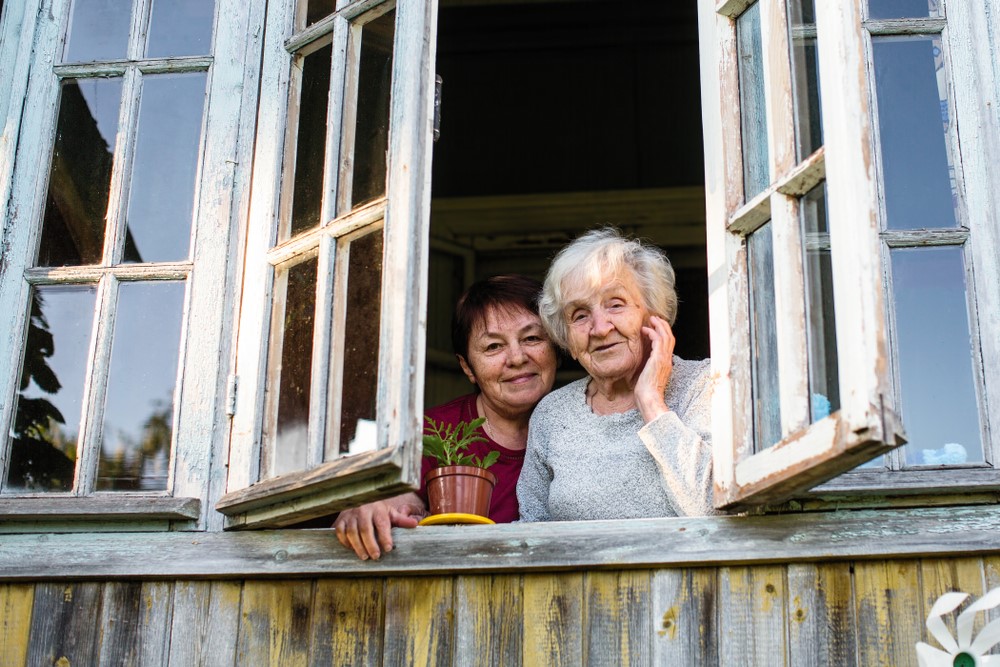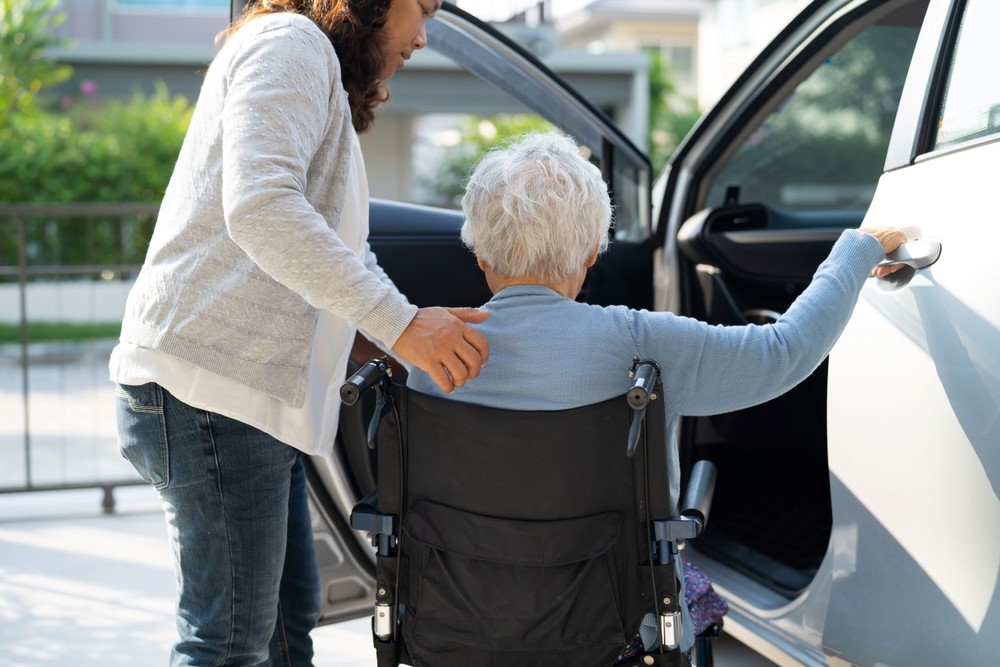
Ask any senior where they want to grow old and the answer will most likely be at home. Home remains the ideal place to age for well over 70% of all seniors, a figure that’s remained fairly consistent, despite the pandemic and all the other challenges of recent years.
This isn’t surprising either.
Who would choose to leave a familiar and safe environment for something completely different? Sure, options like a senior apartment or assisted living might be safer and even more enjoyable for the senior, but they can’t be certain of this until they’ve made the move.
So, for many, the answer is to stay put.
If the senior’s physical and mental abilities stay the same, they may be able to age at home easily, without incident.
That’s a big if though.
Physical and/or cognitive ability often gets worse with age. Seniors may even go from being fully independent to struggling with basic tasks. Some may eventually need help to cook and clean, or even to visit the bathroom.
The potential for such changes means that aging at home requires planning – and a lot of it.
Assuming that a person’s needs and abilities will remain the same as they age isn’t just naive, it’s also incredibly dangerous. To protect the senior, it’s important to plan and get systems in place now, before any problems arise.
We’ve touched on many of these approaches in individual posts here at Kapok.
In this piece, we’re bringing it all together. We’re talking about all the important areas that can help seniors to stay in their own homes, even if their health starts to decline.
Home Safety
It’s easy to see the home as a safe and secure environment. Yet, it can be surprisingly dangerous. More than 50% of all injury-related accidents happen at home. Falls are particularly common for seniors, leading to more than 30,000 deaths every year.
That’s not even counting all the times where falls lead to severe injuries or permanently change a senior’s mobility.
Many homes are full of hazards that increase the risk of falls, including stairs, loose cords, rugs, and slippery floors.
Such hazards become an increasing issue with age, especially as eyesight, balance, and cognition sometimes decline as people get older.
It’s best to make changes early, long before they’re needed. After all, even a minor fall can have serious negative impacts.
Changes don’t need to be huge either. Sometimes even the simple things can have a huge impact. The resources below highlight key ways that you can make the home much safer.
- 11 Bathroom Safety Tips for Seniors
- Kitchen Safety for Seniors
- How To Make The Home Safe For Seniors
- Top Safety Tips For Seniors Living Alone
Related: Checklist for Elderly Living Alone – What To Look For When You Visit
Consider Adaptive Products

Adaptive products are designed to help with the basic functions of daily life, whether this is moving from one room to the next, eating, bathing, toileting, getting dressed, or something else.
Such products actually promote independence, as they help the senior to meet their own needs, rather than relying on outside help.
Adaptive clothing and footwear, for example, make it easier for seniors to dress themselves. The clothing can help with incontinence too, as it can be quickly removed when needed.
A senior might use a reacher to extend their range of motion or shower accessories to make bathing a little easier. We’ve covered many other products in our post on adaptive aids for seniors and caregivers.
Related: Paying For Assistive Aids That Help Seniors
Learn About Relevant Conditions
Many seniors experience multiple chronic conditions, which can impact their health and well-being.
These are scary, so you might try to ignore the complexities and figure out the condition as it goes.
However, to promote health, it’s best to do the research early. This way, you know exactly what to expect and can stay one step ahead.
This is particularly true for dementia.
Reading ahead on dementia can be terrifying, especially if your loved one is in the early stages. However, both you and the senior need to understand how the condition may progress – as important decisions must be made.
For example, caring for someone with dementia requires different approaches than normal caregiving, especially as you mightn’t be able to reason with them in a regular way.
The process also gets increasingly difficult as the disease progresses. Most families get to the point where the senior needs to be in a specialized facility. Trying to care for them at home often isn’t safe or wise, as they may need more support and structure that you can provide (the movie The Father is a great illustration of how overwhelming dementia can become).
Diabetes is another important condition to learn more about. Diabetes education classes can teach seniors the lifestyle changes they need to make and how they can still thrive. A diabetes tracking sheet can help seniors or caregivers to manage diabetes supplies well and stay on track.
Other challenges are worth thinking about too, like incontinence, wound care, water retention, and mental health.
Get Support Systems in Place
Most seniors can’t age in place on their own. They’re going to need support.
It’s important to identify needs and possible support systems early. This way adult children aren’t asked to do increasingly more as time goes on.
Food
What happens if the senior starts to struggle with cooking?
Could they turn to meal kit services? These ship ingredients and recipes straight to their door. Some focus on simple meals too, making it easy for seniors to eat healthily.
Can you cook for them? What about other family members or people in your local community?
You might even be able to get a neighbor to bring them food regularly for a small fee.
There are also meal delivery services. Meals on Wheels works well for seniors with limited income. Those in a better financial position might turn to for profit companies, including those that focus on high quality delivered food.
Magic Kitchen and Mom’s Meals are two options that both focus on seniors. The services also work with some health plans, so you may be able to get the meals at a fairly low cost.
Related: Fast And Easy Meals For Caregivers To Prepare
Transportation

Transport is crucial too. It’s needed for medical appointments, grocery shopping, social engagement, and much more.
That’s not all. Being able to get around is a key aspect of independence. Remember what it was like when you could first drive for yourself? When you no longer needed to ask for rides?
Seniors still look for this independence.
Even if your aging parent can currently drive themselves, it’s important to look for alternatives early. That way needing to stop driving doesn’t take away their independence.
Some options to consider include:
- Giving the senior rides yourself. This is often the go-to for families. It can work well, but only if it’s not too overwhelming for you. The senior may need other options as well, so that they still have a sense of independence.
- Taxis. You may be able to find discounts on taxi fares.
- Rideshare services, like Uber. These services are often cheaper than taxis and provide social connection too. Some companies allow you to order rides for someone else, which makes the process even easier.
- Public transport. This will depend on the senior’s physical abilities and the transport system in your area. But, when all works well, public transport can be an incredible boon.
- Local services. Senior centers may offer transport services for seniors and some small local businesses may do so as well.
There are also some more obscure options, including HopSkipDrive. This rideshare service mostly focuses on safe services for youth, but they offer transport for seniors as well.
Social Connection
Humans tend to be tribal. We need connection with other people – and don’t do well without it.
This can be a challenging area for seniors, particularly those aging at home.
After all, seniors have lost the almost daily social connections that come from having a regular job. They may have fewer activities as well and could find it more difficult to leave the house.
Plus, friends of the same age may face mobility issues too, making connection even more difficult.
There are plenty of programs that aim to bridge this gap, including exercise classes, walking groups, and activities at local senior centers.
It’s important to be proactive here – to make sure the senior has regular activities with other people that they enjoy. This is crucial, as it’s often hard for people to connect socially once they’ve been isolated for a while. Keeping the rhythm of connection and friendships simply makes everything easier.
Related: Finding Solutions For Loneliness In Seniors
Make Financial Plans
Aging at home often comes with additional costs.
Approaches like home modifications, adaptive tools, care services, and delivered meals all have a price tag. These costs add up quickly. That’s not even counting all the medical costs that seniors may also face.
At the same time, seniors often have a limited income.
Their finances may quickly get stretched thin.
Adult children often step in to fill in the gap. But, while this works in the short term, it’s probably not sustainable. What are some other options?
Start Saving Early
The earlier you can start saving, the better.
This might include family members saving, as well as the senior themselves.
They may need a savings plan in place or to talk to a financial planner about ways to reduce their spending.
Here are some articles that can help:
- The Complete List Of Senior Discounts For 2022 – Senior Living
- Powerful Money Saving Tips For Seniors
- Essential Financial Advice For Seniors
- Best Apps For Selling Stuff
- Best Side Hustles For Caregivers And Seniors
Look For Long-Term Care Financing

The government offers plenty of support for aging at home, through Community Based Long-Term Care Programs. These are designed to help seniors age at home, rather than in facilities.
The U.S. Administration on Aging’s Eldercare Locator is one of the best tools for finding programs in your area. You can also talk to local senior centers and aging specialists, who may have extra insights about your options.
The specific programs vary from one state to the next. Some run through Medicaid and seniors need to be eligible for Medicaid to use them. Others are non-Medicaid. These have different eligibility requirements, but most still have some form of income threshold.
The income requirements for these programs are based on the senior’s income, NOT the income of family members. Plus, if the senior is above the income threshold for such programs, they may be able to afford to pay for support themselves.
Long-term care insurance can be an option too.
This is best put in place long before your parents need support. The specific policy makes a huge difference, as you need one that works for care provided in the home. Some policies might even be useful in other ways too, like helping with home modifications.
Can You Get Paid?
It may be possible to get paid to care for your family member. You can find more details in our post: How Do You Get Paid To Care For A Family Member?
Most of the time, such pay comes through the Medicaid and non-Medicaid programs we mentioned earlier. Some of these have a self-directed care element, where seniors can choose who is providing their care.
This sometimes allows you to be paid as a caregiver.
Most of the time, the senior will need to meet financial and functional criteria. This often includes being eligible for Medicaid and requiring nursing home level care.
However, there are some serious caveats.
- Criteria and rules vary between states and programs – and seniors aren’t always eligible when you expect them to be.
- There may be restrictions on who can provide care. For example, spouses can be paid as caregivers through some programs and not others.
- There’s normally a cap to the weekly or monthly hours you’ll be paid for and the allowed hours might not cover all of your loved one’s needs.
- Being paid as a caregiver changes the dynamic between you and your parent. It can make things more challenging, especially if your relationship was tense anyway.
- You will normally be following some form of contract, with specific tasks to complete. This can be stressful.
Have the Difficult Conversations
There’s one big ongoing theme with aging at home – planning.
This is the part that seniors and family members often miss. It’s much easier to simply carry on as-is and hope that doing so is enough.
But, planning is essential for keeping seniors safe.
This means having some difficult conversations with the senior and the wider family. It includes talking about some of the ‘what ifs’ that no one wants to, including dementia, incontinence, finances, and end of life.
Think and Talk About Your Role

It’s also important to talk about the adult children, particularly the types of support they’re willing to provide and the types they’re not.
This is crucial, as many families don’t have these conversations. Instead, each person has their own assumptions about how things are going to go.
For example, what happens if your aging parent can’t safely live alone anymore?
Would they be willing to hire home help? Can they afford do so?
What if the amount of help needed exceeds what they can afford?
Would you move in with them (or them with you)? Many families take this approach. There are serious benefits to doing so, but plenty of risks as well.
Here are some important questions and resources when considering what to do next:
- My Elderly Mother Expects Me To Support Her
- What If I Don’t Want To Care For My Aging Parent? – Forbes
- Am I Responsible for My Aging Parents? – WebMD
- How To Set Healthy Boundaries For Caregivers
- The Best Responses When Aging Parents Expect Too Much
- Having Difficult Conversations With Aging Parents
There’s a social expectation that we care for our parents. Many of us expect this of ourselves too.
Life is more complicated than that though.
Adult children need to decide individually where they’re going to draw boundaries. For example, you might provide plenty of support and help your parent to hire good caregivers, but choose not to be a caregiver yourself.
You could also simply not have the time or the financial flexibility to support your parent. It’s a big ask, after all, and we can’t all manage it. What if you’re only just keeping afloat yourself?
Related: Pros And Cons Of Aging At Home
What If It Doesn’t Work Out?
While aging at home is the ideal, it won’t always be possible.
Perhaps the senior can no longer live on their own and adult children aren’t able to provide enough support. Or, their health issues may make living at home untenable.
The family might be able to pull together for a while, but this quickly gets overwhelming for everyone involved.
It’s often best to talk about aging at home as an ideal.
Perhaps you say that you’ll do your best. That you’ll work on helping the senior to age at home, but don’t make a promise.
We can’t predict the future. You have no way of knowing what things will look like in five years, ten years, or even one year.
And honestly, making a promise you mightn’t be able to keep isn’t kind. It places too much pressure and guilt on you – and gives them false hope.
It’s much better to talk things through early. This way, the senior has time to adjust. To think about what the next place may look like and perhaps even get excited.
What If They Don’t Want To Adapt?
Throughout this post, we’ve been assuming a collaborative relationship between aging parents and their children, where the parent is willing to plan for the future and make allowances for changes as they age.
But, this often isn’t the case.
Loss of independence is a huge fear for many seniors. Some respond to it by trying to live exactly as they always have. They may even reject all help and refuse to talk about any potential change in their abilities.
There are a few important things here.
First, you can’t force someone to change their mind. It has to be their decision.
This means that trying to pressure or bully them rarely works. You might simply make them dig their heels in even more.
It’s much better to tread gently, with respect. This includes looking at where they’re coming from and what matters to them.
A collaborative approach often works well.
Here, the goal is to find solutions together. For example, “Dad, we want to keep you independent at home for as long as possible and we’re worried about you falling. What can we do to make things safer?”
Being collaborative like this often feels better for the senior, as their independence isn’t being threatened.
Things may take time though.
Some seniors may not want to talk about change at all initially. They may need time to adjust to the idea. Or, they may need their own wake up call that they’re not as young as they once were.
So, be patient and lean into respect (even when it’s difficult).
Aging parents often come around, sooner or later. You might find that you start to come around to some of their views too.
Final Thoughts
Aging at home is possible for many seniors. Many programs provide some financial or practical support to help meet the senior’s needs and keep them independent for as long as possible.
But, this isn’t a topic to take lightly.
Planning, talking about finances, and making modifications to the home are often essential for keeping the senior safe as they age.
It’s also important to remember that aging at home doesn’t always work. Sometimes the senior has too many health needs or other challenges make aging at home unsafe. This doesn’t mean you’ve failed. After all, life doesn’t always work out the way we want it to.
Advance Planning Coaching
It’s never too early to think about the future. Kapok’s Advance Planning service can help you understand the process of advance care planning, including the paperwork involved and important areas to think about.

Leave a Reply